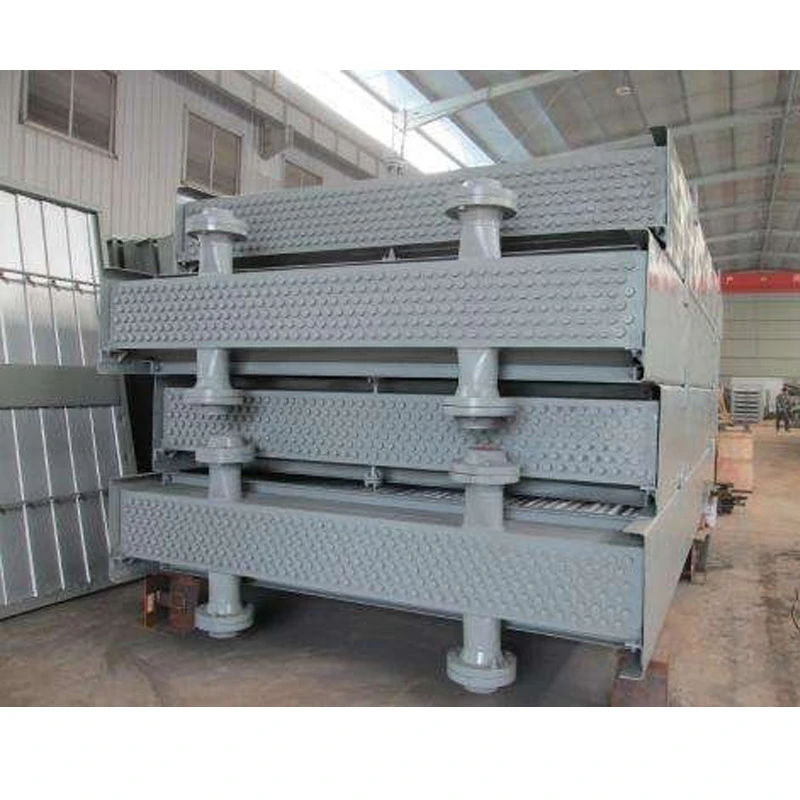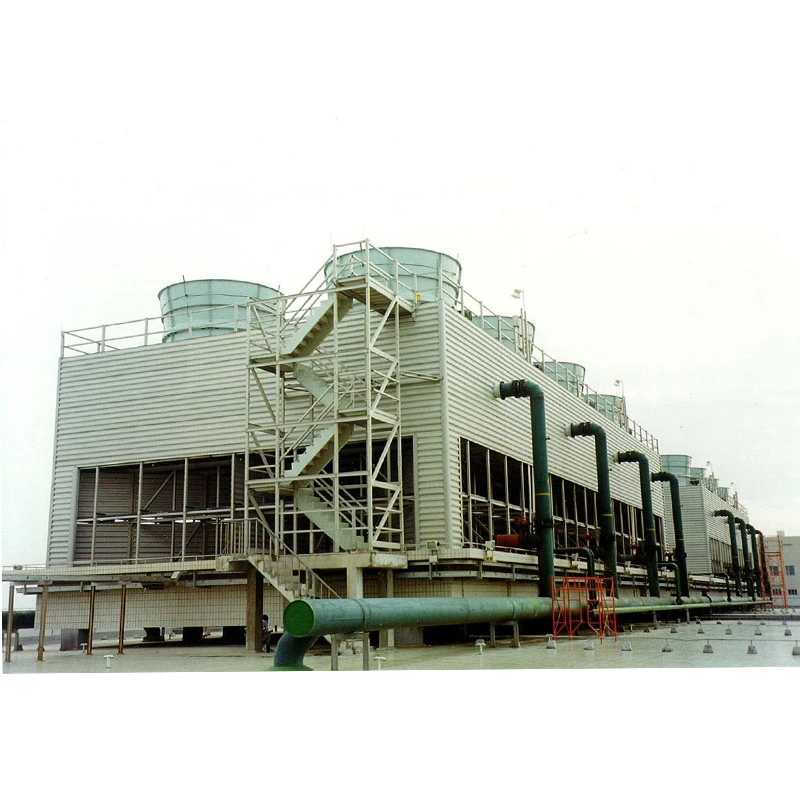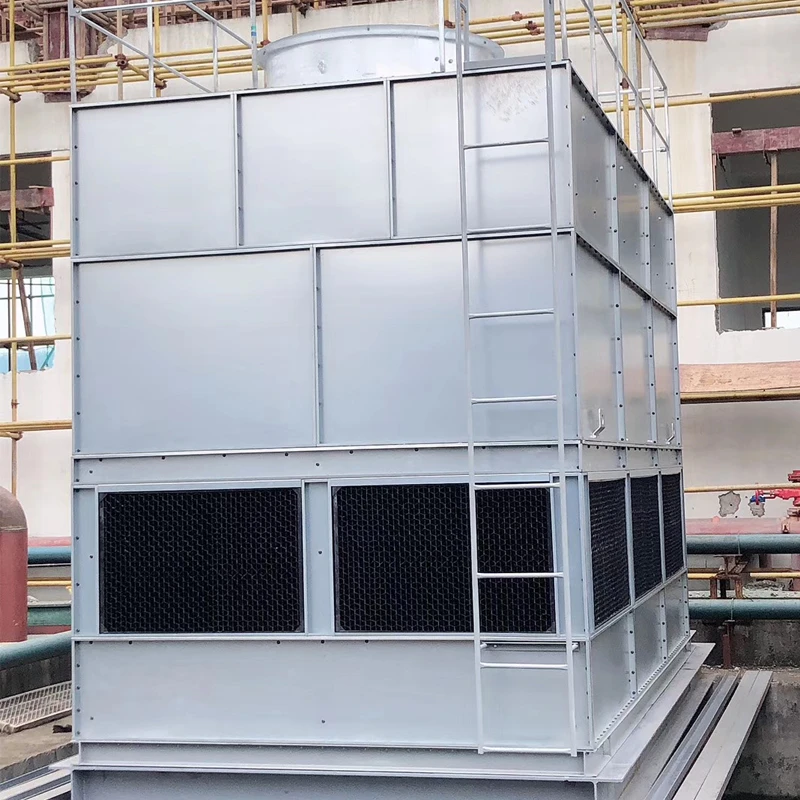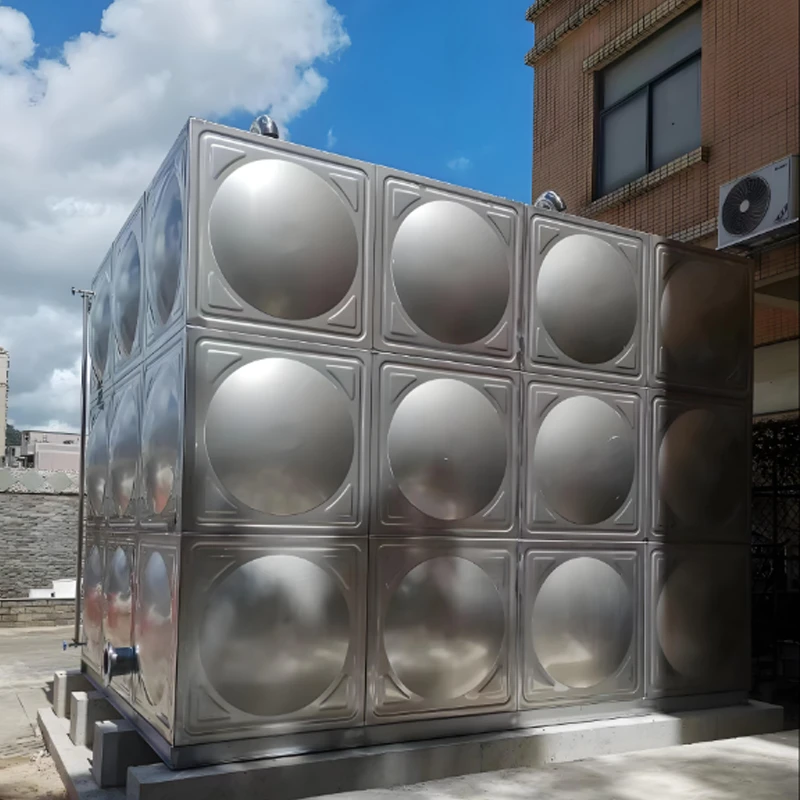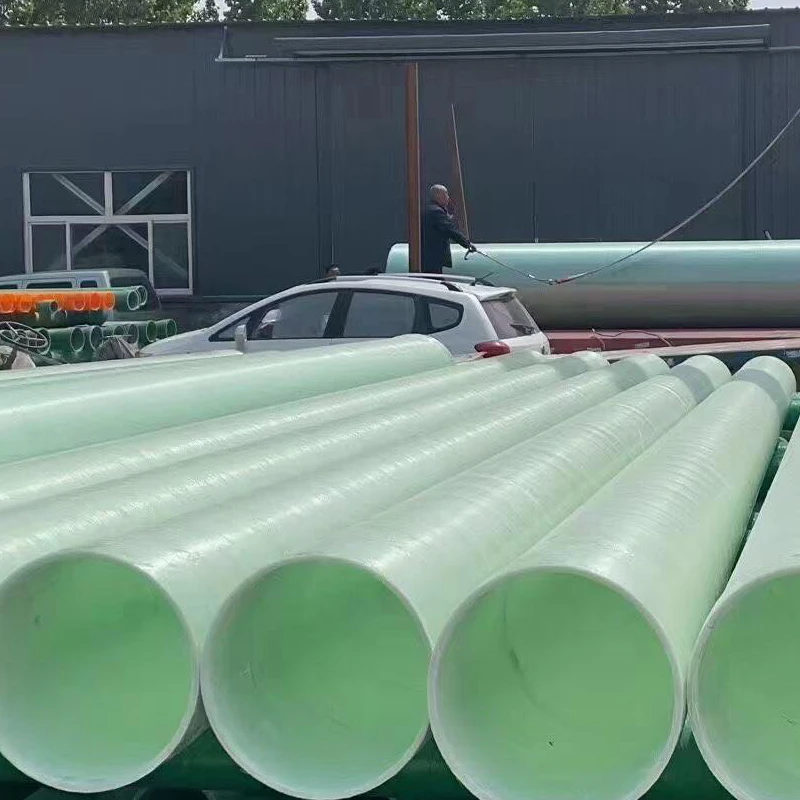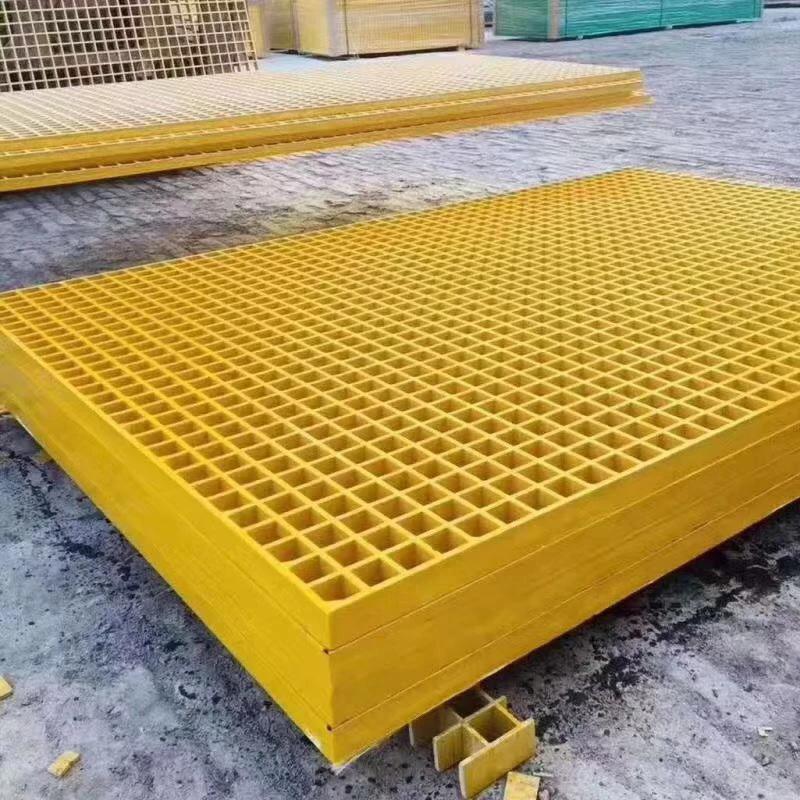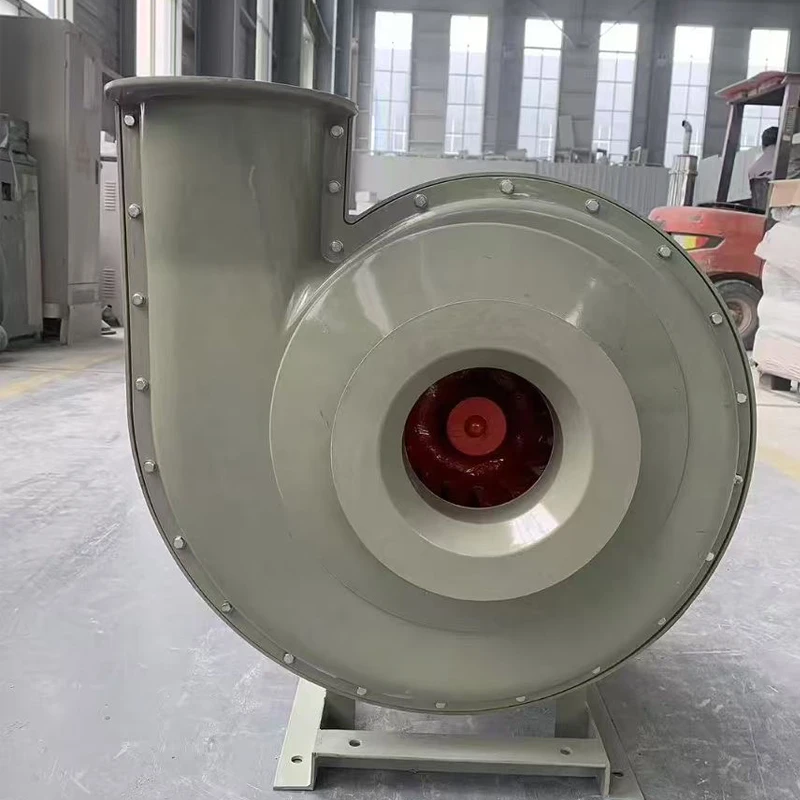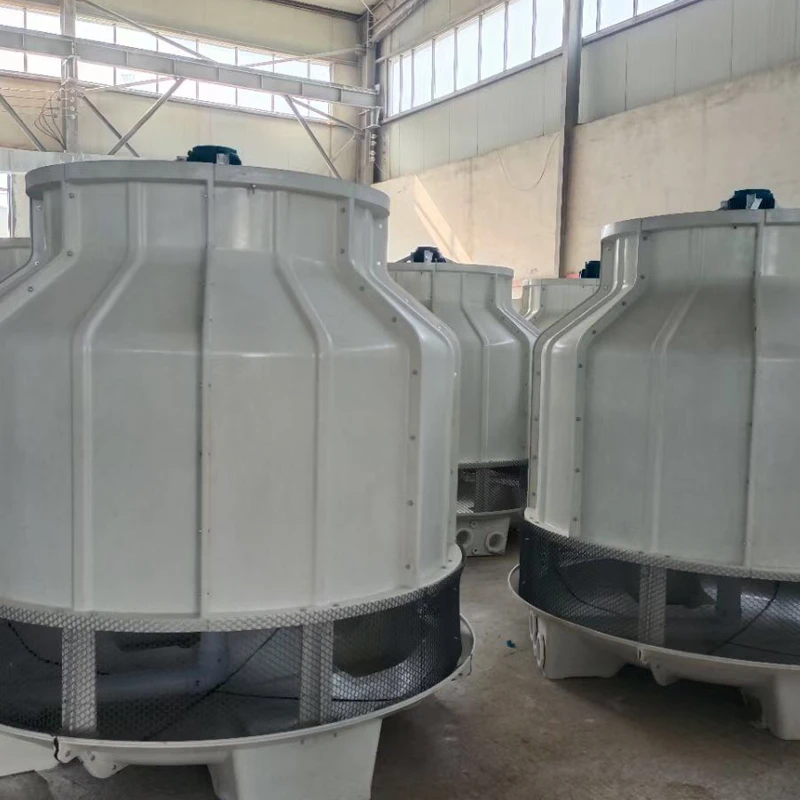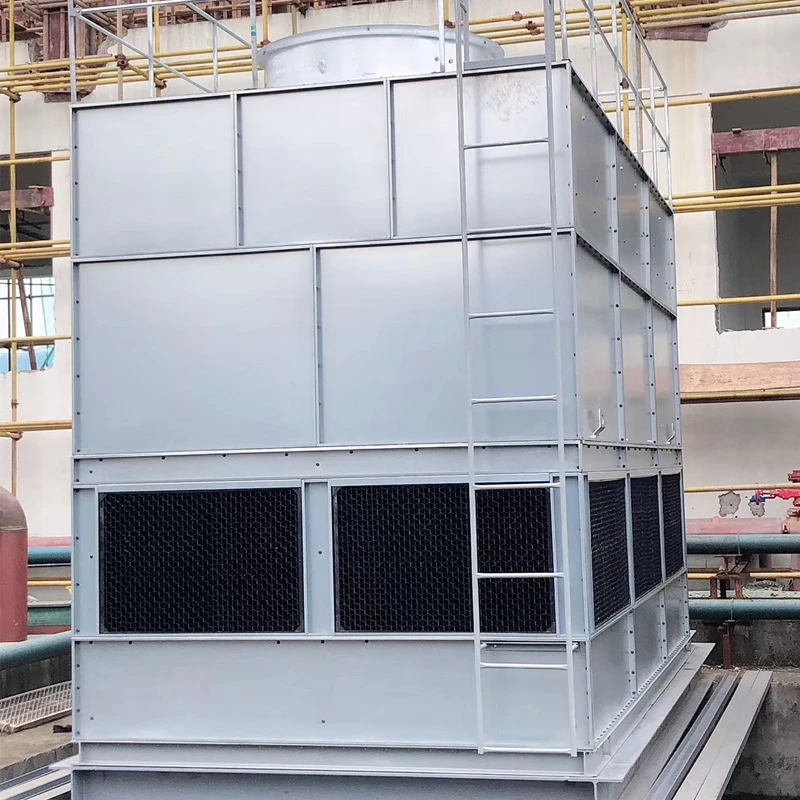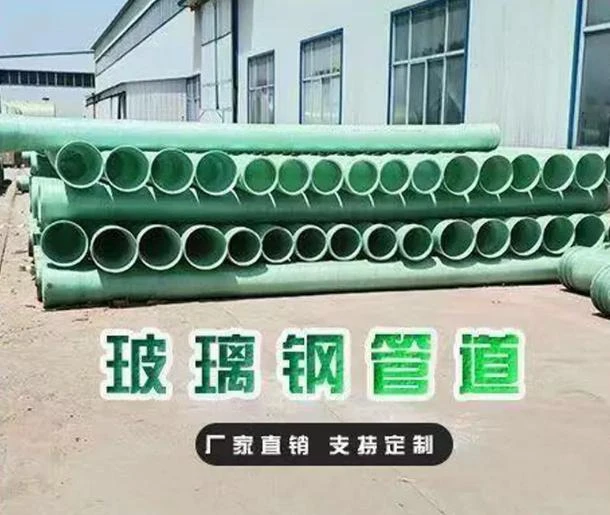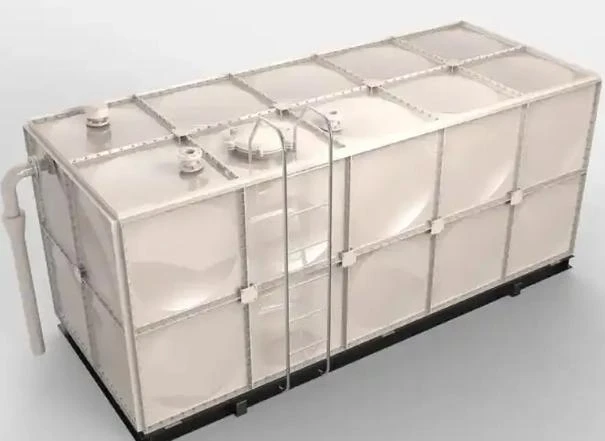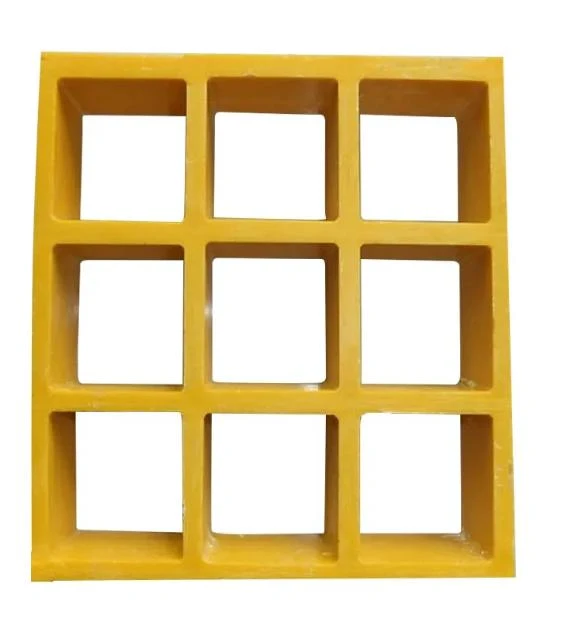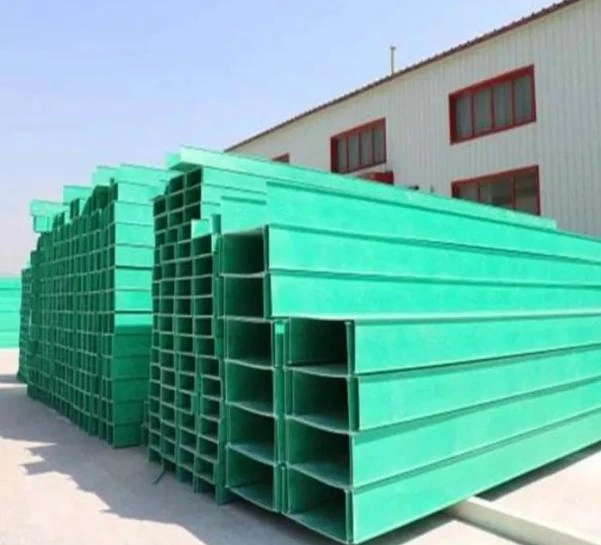

We Are Open 24 Hours a Day, 7 Days a Week, Including Weekends and Public Holidays.
In the vast landscape of industrial operations, efficient air movement and ventilation are paramount for safety, productivity, and environmental compliance. When it comes to handling corrosive gases, hazardous fumes, or simply moving large volumes of air in demanding environments, the choice of equipment is critical. This comprehensive guide delves into the world of centrifugal fans for sale, with a particular focus on the advanced capabilities and benefits of Frp Centrifugal Fan technology, specifically designed to meet the rigorous demands of modern industries. We will explore industry trends, technical intricacies, diverse applications, and the distinct advantages that make these fans an indispensable asset.
Industry Trends and the Evolving Landscape of Industrial Ventilation
The industrial ventilation sector is continually evolving, driven by stringent environmental regulations, increasing energy efficiency demands, and advancements in material science. There's a growing global emphasis on sustainable manufacturing practices, leading to a surge in demand for durable, energy-efficient, and corrosion-resistant air moving solutions. Traditional metal fans, while robust, often fall short in highly corrosive or chemically aggressive environments, leading to frequent maintenance, reduced lifespan, and increased operational costs. This has spurred a significant shift towards specialized materials like Fiberglass Reinforced Plastic (FRP), which offers unparalleled resistance to a wide range of chemicals.
Another prominent trend is the integration of smart technologies. Industries are increasingly adopting Variable Frequency Drives (VFDs) with centrifugal fans for sale to optimize performance, reduce energy consumption, and allow for precise control over airflow rates. The market for large centrifugal blower and large centrifugal fan units is also expanding, especially in heavy industries requiring massive air displacement capabilities. Furthermore, customization is key, as no two industrial applications are exactly alike, demanding bespoke solutions tailored to specific parameters like pressure, volume, temperature, and chemical composition of the airstream.
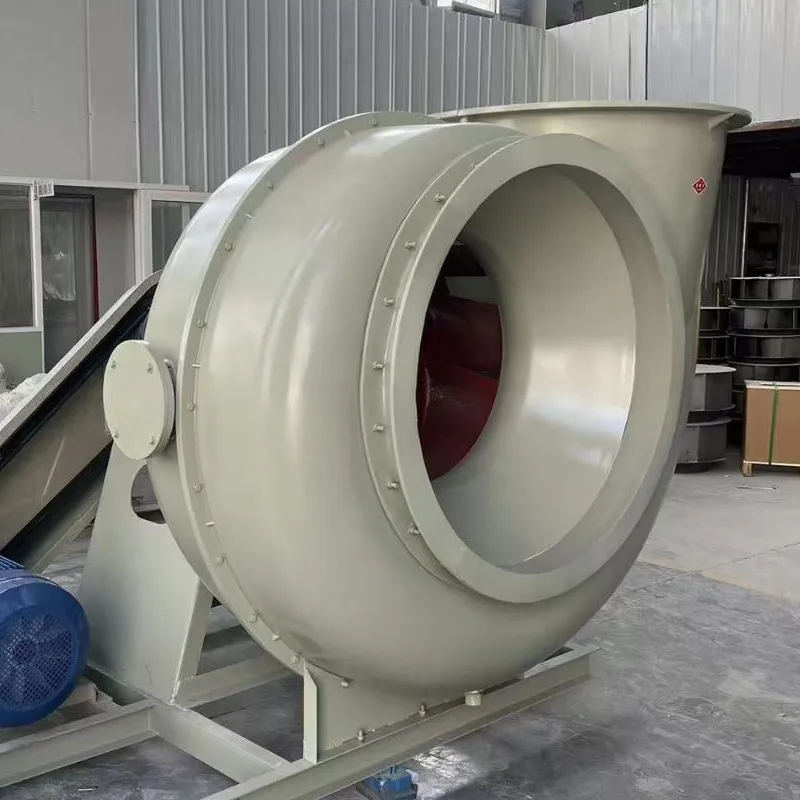
Understanding the Technical Parameters of Centrifugal Fans
To select the optimal centrifugal fans for sale for any application, it's crucial to understand their core technical parameters. These metrics define the fan's performance and suitability for specific tasks:
- Air Volume (CFM/m³/h): This refers to the total volume of air the fan can move per unit of time. It's a primary indicator of the fan's capacity and is measured in Cubic Feet per Minute (CFM) or cubic meters per hour (m³/h).
- Static Pressure (Pa/in.wg): This is the resistance the fan must overcome to move air through a duct system, filters, or other components. It's measured in Pascals (Pa) or inches of water gauge (in.wg). Higher static pressure indicates a fan's ability to push air against greater resistance.
- Total Pressure: The sum of static pressure and velocity pressure. Velocity pressure is the kinetic energy of the moving air.
- Fan Efficiency: A critical parameter, often expressed as static efficiency or total efficiency. It's the ratio of the useful power imparted to the air to the power consumed by the fan motor. High efficiency translates directly into energy savings. For instance, a well-designed frp centrifugal blower can achieve static efficiencies upwards of 70-80% when paired with an optimized motor and impeller design.
- Motor Power (kW/HP): The electrical power required to drive the fan, measured in kilowatts (kW) or horsepower (HP). Proper motor sizing is essential for efficient operation and longevity.
- Noise Level (dBA): The sound pressure level generated by the fan during operation, measured in decibels (dBA). For industrial settings, noise reduction is often a significant design consideration.
- Operating Temperature: The maximum and minimum temperatures of the air or gas that the fan can safely handle. FRP fans can often withstand temperatures up to 100-120°C (212-248°F) depending on the resin system used.
- Corrosion Resistance: The fan's ability to resist degradation from corrosive chemicals, a prime advantage of FRP construction. Different resins (e.g., Isophthalic, Vinyl Ester, Novolac Vinyl Ester) offer varying degrees of resistance to specific acids, alkalis, and solvents.

Introducing the Frp Centrifugal Fan: Innovation in Corrosion Resistance
Longxuan FRP proudly presents its flagship product, the Frp Centrifugal Fan, available at https://www.longxuanfrp.com/frp-centrifugal-fan.html. This product embodies the pinnacle of engineering for demanding industrial applications. Unlike traditional fans made from steel or stainless steel, which can quickly succumb to corrosion in aggressive chemical environments, our FRP fans are constructed from advanced composite materials, offering superior chemical resistance, lighter weight, and excellent durability.
Detailed Manufacturing Process of Centrifugal Fans for Sale (Frp Centrifugal Fan)
The production of a high-quality Frp Centrifugal Fan is a meticulous process that combines material science expertise with precision manufacturing techniques. The inherent strength and corrosion resistance of FRP come from the synergistic combination of a thermosetting resin matrix and reinforcing glass fibers. Here's a detailed look at the manufacturing journey:
- Resin and Fiberglass Preparation: The process begins with the selection of high-grade resins (e.g., Isophthalic polyester, Vinyl Ester, or Novolac Vinyl Ester) chosen based on the specific chemical resistance requirements of the end application. Fiberglass in various forms (mat, roving, woven fabric) is also prepared.
- Mold Preparation: Precision molds, often made from steel or highly polished composites, are used to define the exact shape of the fan casing, impeller, and other components. These molds are meticulously cleaned and coated with a release agent to ensure easy demolding and a smooth final surface.
- Gel Coat Application: A specialized gel coat, often pigmented and highly resistant to environmental factors, is applied to the mold surface. This layer forms the outer protective skin of the fan, providing chemical resistance and a smooth finish.
-
Laminate Lay-up (Hand Lay-up & Filament Winding):
- Hand Lay-up: For complex shapes like the fan casing, layers of fiberglass mat and resin are manually applied to the mold. Skilled technicians saturate the fiberglass with resin, removing air bubbles to ensure a void-free laminate. Multiple layers are built up to achieve the desired thickness and structural integrity.
- Filament Winding: For components requiring exceptional strength, such as cylindrical sections of large diameter ducts or certain impeller hubs, filament winding may be employed. Continuous strands of fiberglass are precisely impregnated with resin and wound onto a rotating mandrel in a pre-programmed pattern, creating a highly uniform and strong composite structure.
- Curing: Once the laminate is fully laid up, the resin undergoes a curing process, where it chemically reacts and hardens into a rigid, thermoset plastic. This can involve ambient temperature curing or elevated temperature curing in an oven for accelerated and more complete polymerization.
- Demolding: After curing, the hardened FRP component is carefully removed from the mold.
- Component Machining and Finishing: Demolded components undergo precision machining, often using CNC (Computer Numerical Control) equipment, to ensure exact dimensions, smooth edges, and proper fit for assembly. This includes drilling holes, trimming excess material, and ensuring critical tolerances for impeller balancing and shaft alignment. CNC machining ensures consistent quality and interchangeability of parts.
- Impeller Balancing: The impeller, the heart of the centrifugal fan, is dynamically balanced to extremely fine tolerances (e.g., ISO 1940-1 Grade G2.5). This crucial step minimizes vibration, reduces noise, prevents premature bearing wear, and ensures smooth, long-term operation. Unbalanced impellers can lead to catastrophic failure.
- Assembly: The various FRP components (casing, impeller, inlet cone, discharge cone) are assembled with corrosion-resistant fasteners. The fan shaft, bearings, and motor are then integrated into the assembly. Precision alignment is verified during this stage.
-
Quality Inspection and Testing: Every centrifugal fans for sale unit undergoes rigorous quality control. This includes:
- Visual inspection for surface defects, resin rich/starved areas.
- Dimensional checks to ensure compliance with design specifications.
- Performance testing: Airflow volume, static pressure, motor current, and vibration levels are measured and compared against design parameters. This often adheres to AMCA (Air Movement and Control Association) standards, such as AMCA 210 for fan performance.
- Hydrostatic testing (for pressure vessels within the system, if applicable).
- Spark testing for internal lining integrity to ensure no pinholes in corrosive applications.
- Packaging and Shipping: Once all tests are passed, the fan is prepared for shipment, often with protective coatings or crating to prevent damage during transit.
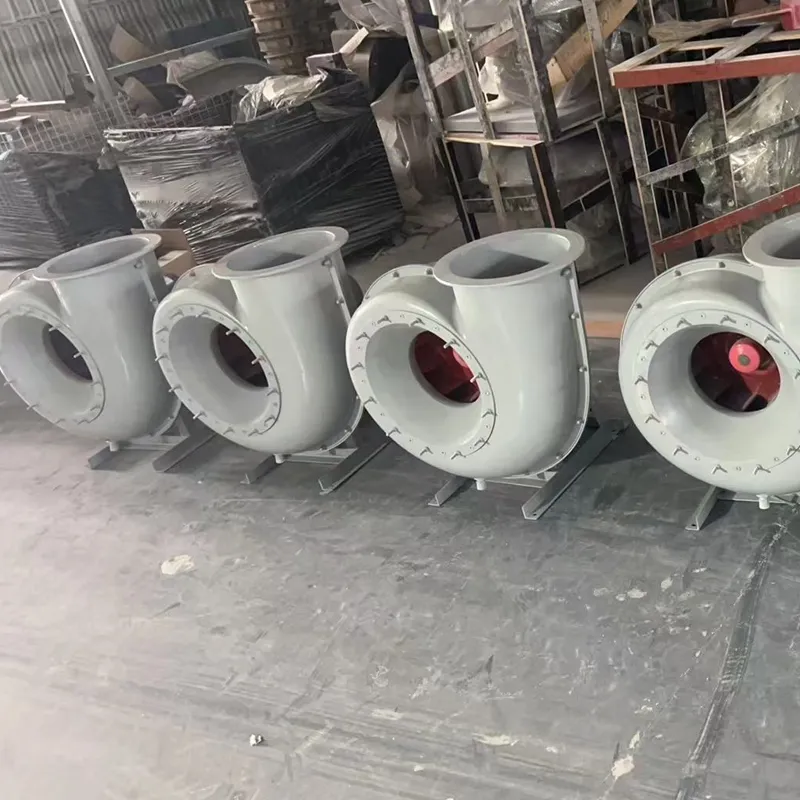
Materials and Craftsmanship: The Core of FRP Fan Superiority
The choice of materials and the meticulous manufacturing process are what set Frp Centrifugal Fans apart.
- Product Material: The primary construction material is Fiberglass Reinforced Plastic (FRP). This composite offers exceptional properties:
- Corrosion Resistance: Superior to metals in acidic, alkaline, and solvent-rich environments. Vinyl ester resins, for instance, are highly resistant to strong acids and chlorinated compounds.
- High Strength-to-Weight Ratio: FRP is lighter than steel, making installation easier and reducing structural support requirements, while offering comparable strength.
- Non-Conductive: Inherently non-conductive, offering safety in certain environments.
- UV Resistance: External surfaces often incorporate UV inhibitors for outdoor installations.
- Manufacturing Process Highlights:
- Precision Hand Lay-up/Filament Winding: Ensures consistent laminate thickness and structural integrity, critical for components like the large centrifugal blower casing.
- CNC Machining: Guarantees precise dimensions and concentricity for impellers and shafts, leading to smoother operation and extended bearing life.
- Dynamic Balancing: Impellers are balanced to ISO 1940-1 (Grade G2.5) or better, which is a key factor in minimizing vibration and ensuring long-term reliability.
- Detection Standard: Our fans adhere to rigorous international standards, including:
- ISO 9001: For Quality Management Systems, ensuring consistent product quality.
- AMCA Standards: Such as AMCA 210 for fan performance testing, AMCA 99 for general classifications, and AMCA 204 for fan vibration.
- ANSI (American National Standards Institute): Relevant sections pertaining to industrial fan design and safety.
- NACE International Standards: For corrosion prevention and control in material selection.
- Service Life: With proper selection, installation, and maintenance, a Longxuan Frp Centrifugal Fan is engineered for an exceptionally long service life, typically exceeding 15-20 years in highly corrosive environments where metal fans would fail in a fraction of that time. This significantly reduces total cost of ownership.
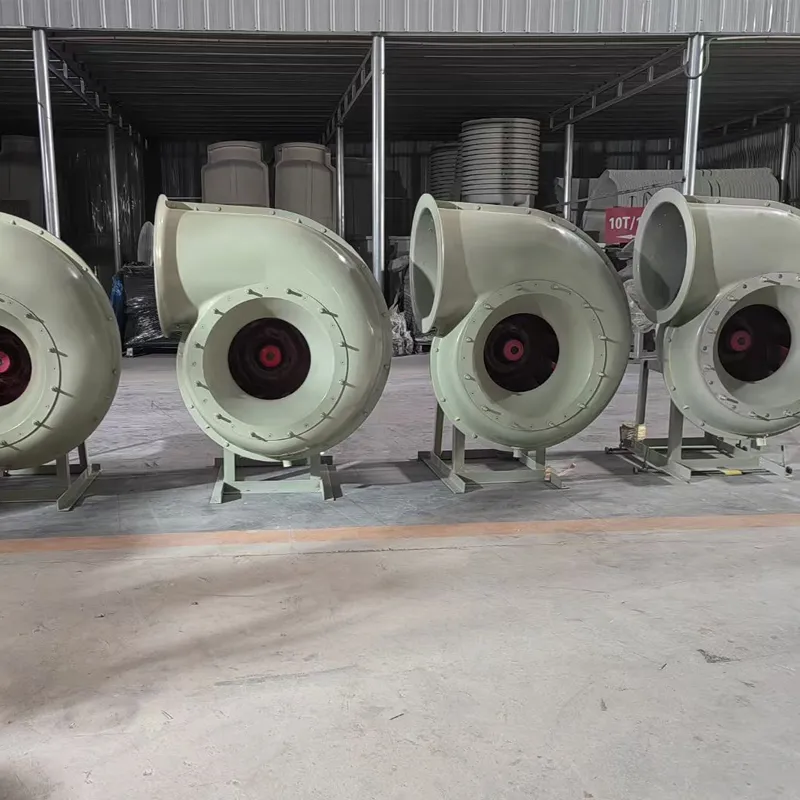
Application Scenarios and Industry Advantages
The versatility and robust nature of Frp Centrifugal Fans make them indispensable across a multitude of industries, especially where corrosive or toxic air streams are present.
- Petrochemical Industry: Critical for fume extraction from acid storage tanks (e.g., sulfuric acid, hydrochloric acid), ventilation in chemical processing units, and handling off-gases from scrubbers. Their corrosion resistance to aggressive chemicals like chlorine, sulfur dioxide, and nitric acid vapors is a key advantage.
- Metallurgy and Electroplating: Used for exhausting acidic fumes from pickling lines, chromate plating baths, and various chemical treatment processes where metal fans would rapidly corrode. A large centrifugal blower made of FRP can handle high volumes of acidic mist effectively.
- Wastewater Treatment Plants: Essential for odor control, particularly in headworks, primary clarifiers, and sludge treatment areas where hydrogen sulfide (H2S) gas is prevalent. FRP fans prevent corrosive attack on the fan casing and impeller, ensuring continuous operation.
- Pulp and Paper Industry: Used in bleach plants and chemical recovery areas to handle chlorine dioxide, sulfur compounds, and other corrosive process gases.
- Pharmaceutical and Food Processing: While typically not as corrosive as petrochemicals, FRP fans are used for general ventilation and exhaust where hygiene is critical, and certain cleaning agents or mild acids might be present.
- Mining Operations: For ventilation in areas with acidic leachate or dust containing corrosive elements.
- Semiconductor Manufacturing: Exhausting fumes from etching and cleaning processes involving strong acids and bases.
Advantages in Typical Application Scenarios:
- Energy Saving: Our FRP fans feature aerodynamically optimized impeller designs (e.g., backward curved or airfoil blades) that minimize turbulence and maximize airflow efficiency. When coupled with high-efficiency motors and VFDs, they significantly reduce operational energy costs. A 2022 study by the Fan Manufacturers Association estimated that optimizing fan systems can lead to 20-50% energy savings in industrial facilities.
- Corrosion Resistance: This is the paramount advantage. Unlike metal fans that corrode, pit, and ultimately fail in chemical environments, FRP fans maintain their structural integrity and performance, ensuring long-term reliability and reducing costly downtime for repairs or replacements. They are specifically engineered to resist a broad spectrum of aggressive chemicals.
- Reduced Maintenance: Due to their inherent corrosion resistance and robust construction, FRP fans require significantly less maintenance compared to their metal counterparts in corrosive environments, leading to lower total cost of ownership.
- Lighter Weight: FRP is considerably lighter than steel, simplifying installation and reducing the structural load on buildings or supporting frameworks.
- Spark Resistance: For applications handling flammable or explosive gases, FRP is non-sparking, a critical safety feature when paired with appropriate anti-static treatments.
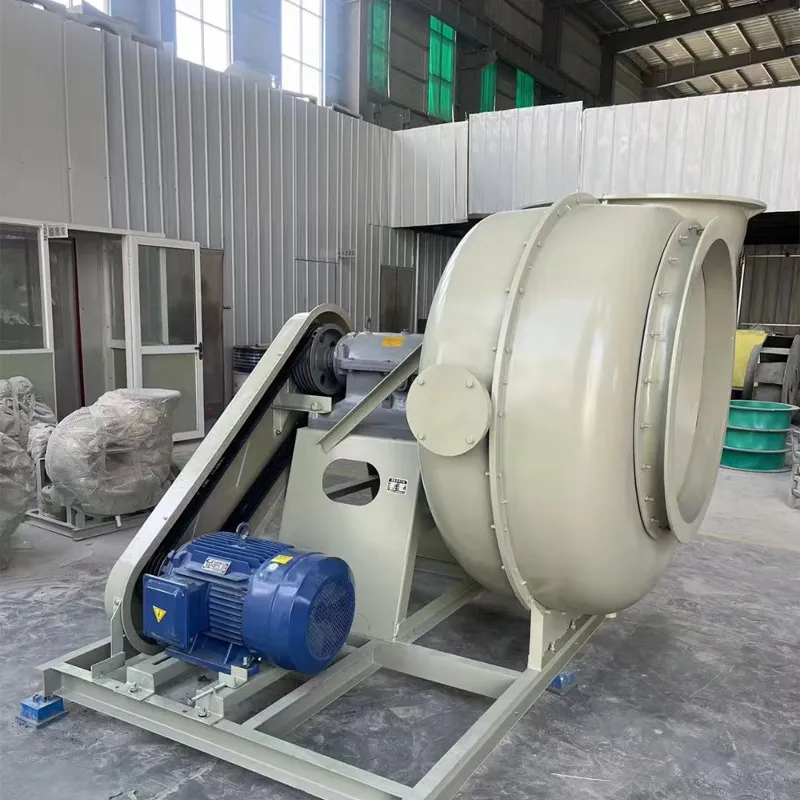
Comparative Analysis: FRP vs. Traditional Metal Centrifugal Fans
When considering centrifugal fans for sale, a critical decision often revolves around the material of construction. While metal fans (carbon steel, stainless steel, alloys) have their place, FRP offers distinct advantages in specific, challenging environments.
| Feature | Frp Centrifugal Fan | Metal Centrifugal Fan (e.g., Stainless Steel) |
|---|---|---|
| Corrosion Resistance | Excellent against a wide range of acids, alkalis, and many solvents. Can be tailored with specific resins. Superior for highly corrosive fumes. | Good against some chemicals, but susceptible to pitting, crevice corrosion, and stress corrosion cracking in aggressive acidic/chloride environments. |
| Weight | Significantly lighter, reducing installation costs and structural support requirements. | Heavier, requiring more robust support structures and potentially higher installation costs. |
| Lifespan in Corrosive Environments | Long (15-20+ years typically), consistent performance due to material integrity. | Reduced lifespan (often 2-5 years or less) due to material degradation, leading to frequent replacement. |
| Maintenance Requirements | Lower; primarily bearing and motor checks. No rust or material degradation to address. | Higher; regular inspection for corrosion, pitting, potential need for coatings/linings, and replacement of corroded parts. |
| Energy Efficiency | High, especially with optimized airfoil or backward inclined impellers. Material smoothness aids airflow. | Can be high, but surface roughness due to corrosion can reduce efficiency over time. |
| Cost (Initial) | Generally higher initial investment due to specialized manufacturing and materials. | Lower initial investment for standard designs. |
| Total Cost of Ownership (TCO) | Significantly lower TCO over the fan's lifespan due to reduced maintenance, longer life, and energy savings. | Often higher TCO due to frequent replacements, higher maintenance, and potential downtime losses. |
| Operating Temperature Range | Limited (typically up to 100-120°C depending on resin). | Higher (can handle very high temperatures). |
This comparison highlights that while the initial cost of Frp Centrifugal Fans might be higher, their long-term value, especially in corrosive environments, far surpasses that of metal alternatives. The reduced downtime, lower maintenance expenditure, and extended operational life contribute to a significantly lower Total Cost of Ownership (TCO).
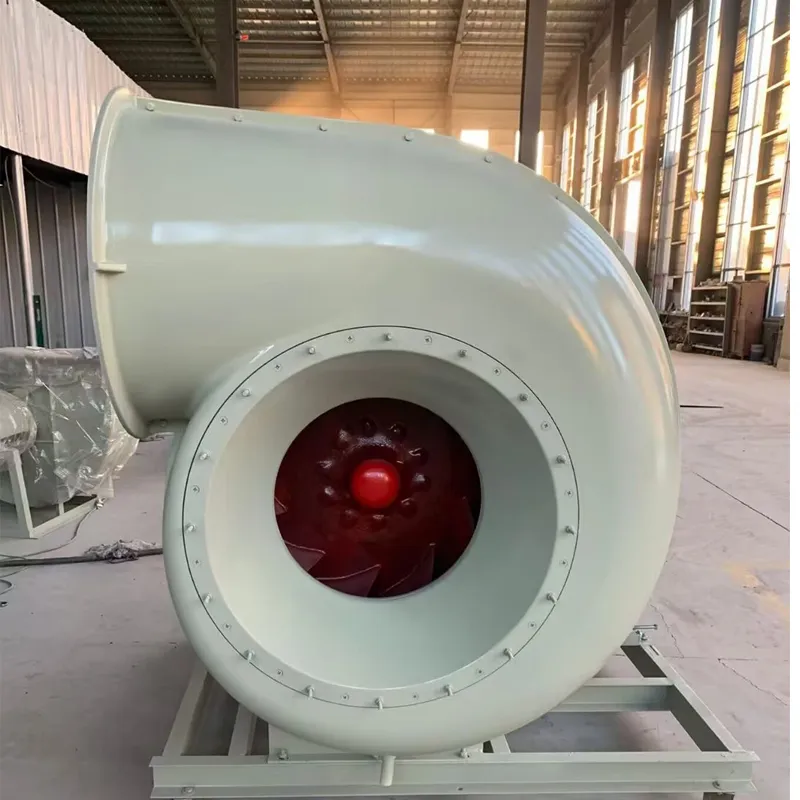
Customization Solutions and Expertise
Recognizing that every industrial process presents unique challenges, Longxuan FRP specializes in offering comprehensive customization solutions for centrifugal fans for sale. Our engineering team works closely with clients to design and manufacture fans that precisely meet their specific operational demands. This includes:
- Material Resin Selection: Tailoring the FRP composite with specific resins (Isophthalic, Vinyl Ester, Novolac Vinyl Ester) to ensure optimal resistance against the exact chemical composition of the airstream. For example, a system handling chlorine gas might require a highly specialized vinyl ester resin.
- Impeller Design: Selecting the most efficient impeller type (backward inclined, radial, airfoil) based on the required airflow volume, static pressure, and efficiency targets. We conduct CFD (Computational Fluid Dynamics) analysis to validate and optimize impeller designs for specific applications.
- Casing Configurations: Offering various discharge angles and arrangements (e.g., top horizontal, bottom horizontal, up blast, down blast) to integrate seamlessly with existing ductwork and plant layouts.
- Drive Types: Direct drive for compact setups and higher efficiency, or belt drive for flexibility in speed adjustment and easier motor maintenance.
- Accessories and Features: Incorporating optional features such as drain connections, access doors, vibration isolators, silencers for noise reduction, explosion-proof motors, and specialized coatings.
- Large Centrifugal Blower Solutions: Designing and manufacturing exceptionally large units for applications demanding massive airflow capacities, ensuring structural integrity and performance even at scale.
Our expertise extends beyond just manufacturing; we provide engineering support, installation guidance, and commissioning assistance to ensure your customized large centrifugal fan operates at peak performance from day one.
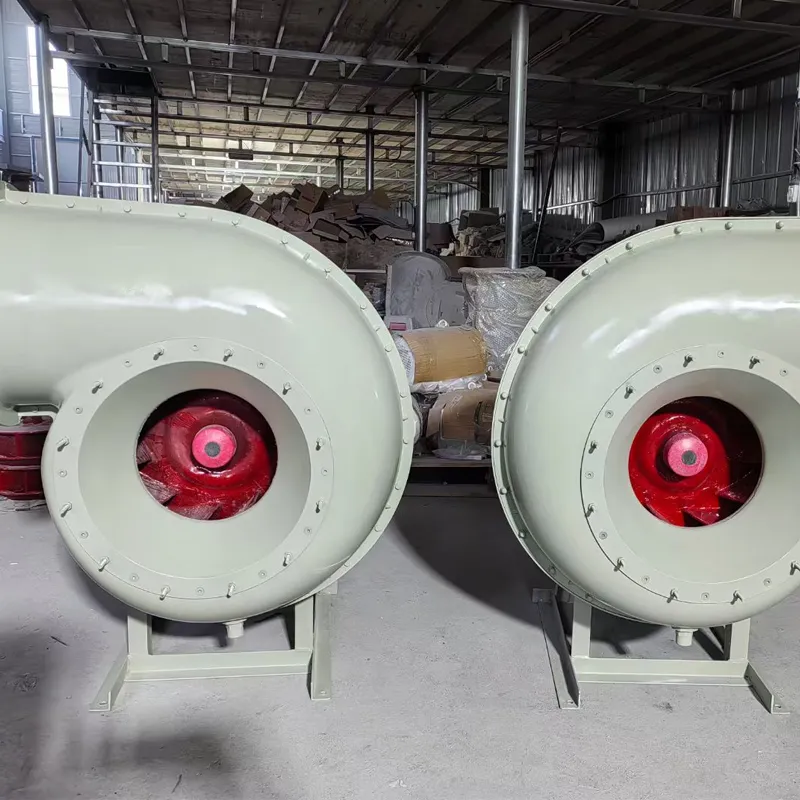
Real-world Application Cases and Customer Experience
Longxuan FRP has a proven track record of delivering reliable and high-performance Frp Centrifugal Fans to a diverse global clientele. Our commitment to quality and customer satisfaction is reflected in the success of our installations.
Case Study 1: Acid Fume Extraction in a Chemical Plant (Petrochemical Industry)
A leading chemical manufacturer faced persistent issues with their existing stainless steel fans in a process unit extracting corrosive sulfuric acid and hydrochloric acid fumes. Fans were failing every 18-24 months due to severe corrosion, leading to costly downtime and safety concerns. Longxuan FRP engineered a custom large centrifugal fan made with a vinyl ester resin system, specifically designed to withstand the high concentrations and temperatures of the acidic fumes. The fan featured a robust, dynamically balanced impeller and a heavy-duty casing.
Outcome: The Longxuan FRP fan has been in continuous operation for over 7 years without any signs of corrosion or significant performance degradation, significantly exceeding the lifespan of previous units. This resulted in a 75% reduction in fan-related maintenance costs and eliminated unscheduled downtime, demonstrating the superior performance and economic benefit of FRP technology.
Case Study 2: Odor Control at a Municipal Wastewater Treatment Plant
A large municipal wastewater treatment facility struggled with persistent hydrogen sulfide (H2S) odors from their headworks and primary treatment areas, causing complaints from nearby residential communities. Their carbon steel fans, used for exhausting the foul air to biofilters, were corroding rapidly. We provided a series of frp centrifugal blower units, designed for low noise operation and excellent H2S resistance, fabricated with an isophthalic resin, which is highly effective against H2S.
Outcome: The installation of our FRP fans dramatically improved the effectiveness of the odor control system. The fans have operated reliably for over 5 years in a consistently corrosive and moist environment, with minimal maintenance. Community complaints regarding odors have significantly decreased, and the plant enjoys a more stable and efficient ventilation system.
These cases highlight our expertise and the tangible benefits our centrifugal fans for sale bring to demanding industrial environments. Our commitment to understanding client needs and delivering tailored solutions ensures long-term operational excellence.
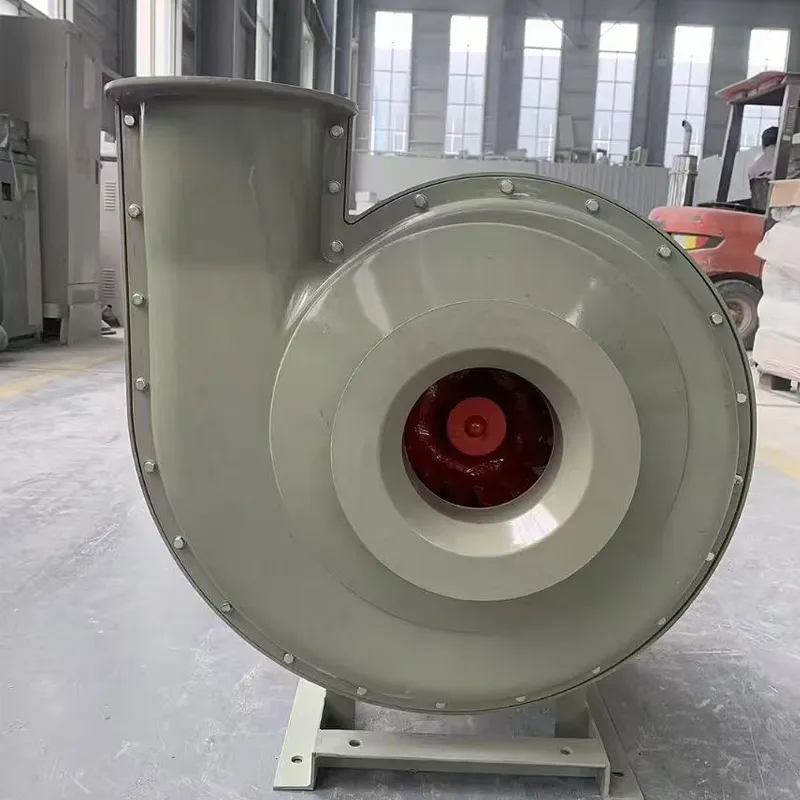
Key Parameters of Centrifugal Fans for Sale (Industry Overview)
To provide a broader context, here's a table summarizing common parameters you might encounter when searching for centrifugal fans for sale across various applications. These are typical ranges, and specific requirements will dictate the exact specifications.
| Parameter | Typical Range / Values | Notes |
|---|---|---|
| Airflow Volume (CFM) | 1,000 to 500,000+ CFM | Smaller fans for localized exhaust, large centrifugal blower for entire facility ventilation or large process streams. |
| Static Pressure (in.wg) | 0.25 to 20+ in.wg (60 to 5000+ Pa) | Low static for general ventilation, high static for complex duct systems, scrubbers, or filtration. |
| Motor Power (HP) | 0.5 HP to 500+ HP | Directly related to airflow and pressure requirements. High efficiency motors (IE3/IE4) are common. |
| Operating Temperature (°C) | -20°C to 120°C (FRP); up to 400°C+ (Metal) | FRP specific resins for higher temps; metal for extreme heat. |
| Impeller Type | Backward Inclined, Backward Curved, Radial, Airfoil | Selection based on efficiency, pressure, air quality (clean vs. particulate). |
| Noise Level (dBA) | 70 to 100+ dBA (at 1m) | Can be mitigated with silencers and enclosures. |
| Typical Lifespan | 15-20+ years (FRP in corrosive); 5-10 years (Metal in corrosive) | Highly dependent on operating conditions and maintenance. |
| Compliance Standards | AMCA, ISO, ANSI, ATEX (for explosive atmospheres) | Ensures performance, safety, and quality. |
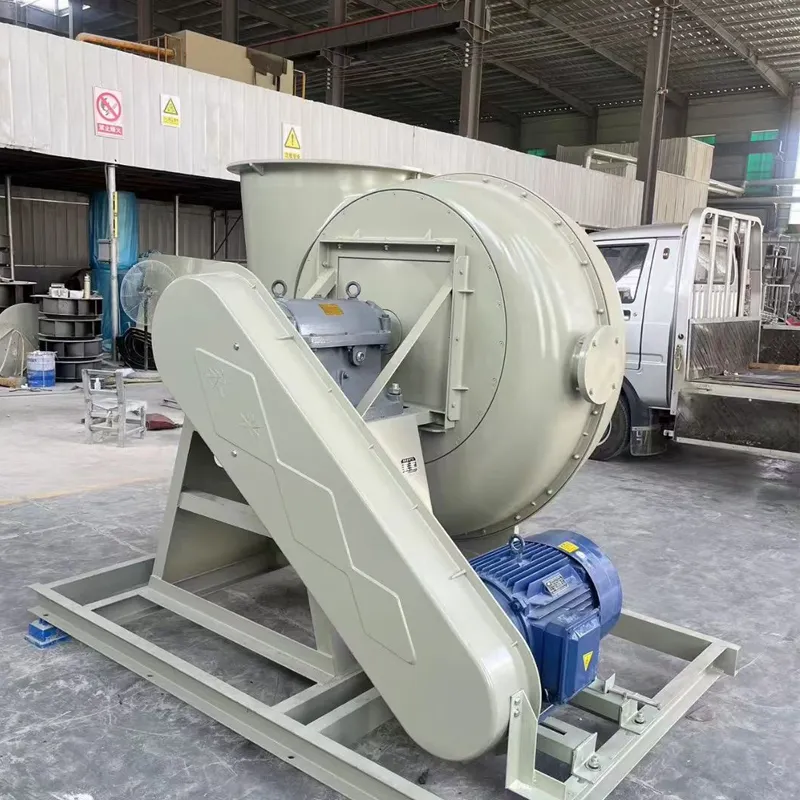
Frequently Asked Questions (FAQ)
To further enhance understanding and address common inquiries about centrifugal fans for sale, especially our FRP models, here are some frequently asked questions:
- Q1: What exactly is FRP and why is it preferred for centrifugal fans in corrosive environments?
- A1: FRP stands for Fiberglass Reinforced Plastic. It's a composite material made by embedding glass fibers within a polymer resin matrix (e.g., polyester, vinyl ester). It's preferred because it offers exceptional chemical resistance to a wide range of acids, alkalis, and solvents that would rapidly corrode traditional metals. It also has a high strength-to-weight ratio, is non-conductive, and has a longer service life in aggressive conditions.
- Q2: What are the key performance parameters I should consider when selecting a centrifugal fan?
- A2: The most critical parameters are Air Volume (CFM or m³/h), which defines how much air the fan moves; Static Pressure (in.wg or Pa), which indicates the resistance the fan can overcome; and Fan Efficiency, which dictates energy consumption. Other factors include operating temperature, noise level, and material compatibility with the airstream's chemical composition.
- Q3: How is fan efficiency measured and why is it important for a large centrifugal fan?
- A3: Fan efficiency is typically measured according to AMCA 210 standards. It's the ratio of useful power delivered to the air to the electrical power consumed by the motor. For a large centrifugal fan, even a few percentage points difference in efficiency can translate into significant energy cost savings over the fan's operational life, making it a crucial factor in TCO (Total Cost of Ownership).
- Q4: What inspection and quality standards do your FRP centrifugal fans adhere to?
- A4: Our fans are manufactured under an ISO 9001 certified Quality Management System. They comply with AMCA (Air Movement and Control Association) standards for performance (e.g., AMCA 210), vibration (AMCA 204), and sound (AMCA 300). We also adhere to relevant ANSI standards for design and safety, and material selection may follow NACE International guidelines for corrosion resistance.
- Q5: What is the typical service life of an FRP centrifugal fan compared to a metal one in a corrosive application?
- A5: An FRP centrifugal fan, properly specified and maintained, can have a service life of 15-20 years or more in highly corrosive environments. In contrast, metal fans (even stainless steel) in similar conditions might only last 2-5 years before requiring significant repairs or replacement due to corrosion.
- Q6: Can your frp centrifugal blower units be customized for specific chemical resistance or operational needs?
- A6: Absolutely. Customization is a core strength. We select specific resin types (Isophthalic, Vinyl Ester, Novolac Vinyl Ester) based on the exact chemical composition of the air stream. We also offer various impeller designs, casing configurations, drive types, and accessories (e.g., drains, access doors, vibration isolators, silencers) to precisely meet unique airflow, pressure, temperature, and installation requirements.
- Q7: What is dynamic balancing, and why is it important for centrifugal fan impellers?
- A7: Dynamic balancing is a process of distributing mass symmetrically around an axis of rotation to minimize vibration. For centrifugal fan impellers, it's crucial because an unbalanced impeller can cause excessive vibration, leading to premature bearing failure, structural damage to the fan or supporting framework, and increased noise. Our impellers are dynamically balanced to ISO 1940-1 (Grade G2.5) or better, ensuring smooth, quiet, and reliable operation.
Trustworthiness: Our Commitment to You
At Longxuan FRP, trustworthiness is the cornerstone of our operations. We are committed to providing not only high-quality centrifugal fans for sale but also an unparalleled customer experience, from initial inquiry to post-installation support.
- Certifications & Authority: We operate under a robust ISO 9001 certified Quality Management System, demonstrating our commitment to consistent quality. Our adherence to international standards like AMCA, ANSI, and NACE underscores our authoritative knowledge in fan design and corrosion-resistant materials. With over [Insert X years, e.g., 20+] years of experience in the FRP manufacturing industry, we have cultivated deep expertise and a strong reputation.
- Transparent Manufacturing: We encourage transparency in our manufacturing processes, ensuring clients understand the quality controls and rigorous testing each Frp Centrifugal Fan undergoes.
- Delivery and Lead Times: We understand the importance of timely project completion. Our production schedules are optimized to ensure efficient manufacturing and reliable delivery. Typical lead times are communicated clearly at the quotation stage, ranging from [e.g., 6-12 weeks] depending on complexity and current production load. We work closely with logistics partners to ensure safe and punctual delivery worldwide.
- Quality Assurance & Warranty: Every Longxuan FRP centrifugal fan is subjected to comprehensive quality checks and performance testing before leaving our facility. We stand behind the durability and performance of our products with a comprehensive warranty program, typically offering a [e.g., 2-year] warranty on materials and workmanship, providing peace of mind to our customers.
- Dedicated Customer Support: Our commitment extends far beyond the sale. We offer dedicated customer support, including technical assistance for installation, operation, and troubleshooting. Our team of experienced engineers is available to provide guidance and ensure the long-term success of your fan system.
- Partnerships: We collaborate with leading engineering firms, EPC contractors, and industrial consultants, ensuring our solutions are integrated seamlessly into large-scale projects and complex industrial systems.
Conclusion
The selection of appropriate air moving equipment is paramount for the operational efficiency, safety, and environmental compliance of industrial facilities. For environments plagued by corrosive gases, hazardous fumes, or aggressive chemical compounds, Frp Centrifugal Fans stand out as the superior, long-term solution. Their unparalleled corrosion resistance, high energy efficiency, reduced maintenance requirements, and extended service life translate into a significantly lower total cost of ownership compared to traditional metal alternatives.
Longxuan FRP is dedicated to providing cutting-edge centrifugal fans for sale, including high-performance large centrifugal blower and large centrifugal fan units, meticulously engineered to meet the most demanding industrial challenges. Our commitment to advanced materials, precision manufacturing, rigorous quality control, and comprehensive customization ensures that our Frp Centrifugal Fan delivers reliable, efficient, and durable air movement solutions that safeguard your operations and contribute to a healthier environment. Invest in Longxuan FRP, and choose a solution built for longevity and performance in the harshest conditions.
References:
- Air Movement and Control Association (AMCA) International. "Fan Application Manual." Retrieved from https://www.amca.org (General reference for fan standards and applications).
- NACE International. "Corrosion Basics - An Introduction." (General reference for corrosion principles and material selection in corrosive environments). Relevant publications available via https://www.nace.org.
- The Fan Manufacturers Association (FMA). "Energy Efficiency in Fan Systems: Best Practices Guide." (For industry data on energy savings). Specific reports may require membership, but general information on efficiency is widely available from reputable industry associations.
- ISO 9001:2015 - Quality management systems — Requirements. (Standard governing quality management systems). More information at https://www.iso.org/iso-9001-quality-management.html.





Address
20 Xingyuan South Street, Zaoqiang County, Hengshui City, Hebei Province, China









